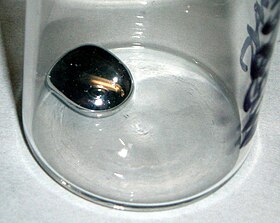Mercury poisoning
| Mercury poisoning | |
|---|---|
| Synonyms | mercury toxicity, mercury overdose, mercury intoxication, hydrargyria, mercurialism |
 |
|
| Elemental mercury | |
| Specialty | toxicology |
| Symptoms | muscle weakness, poor coordination, numbness in the hands and feet |
| Causes | Exposure to mercury |
| Diagnostic method | difficult |
| Prevention | decreasing use of mercury, low mercury diet |
| Medication | acute poisoning: dimercaptosuccinic acid (DMSA), dimercaptopropane sulfonate (DMPS) |
| Classification | |
|---|---|
| External resources |
Mercury poisoning is a type of metal poisoning, due to exposure to mercury. Symptoms may include muscle weakness, poor coordination, numbness in the hands and feet, skin rashes, memory problems, trouble speaking, trouble hearing, or trouble seeing. Symptoms depend upon the type, dose, method, and duration of exposure. The effects of long term low dose exposure to methylmercury is unclear. High level exposure to methylmercury is known as Minamata disease. Exposure in children may result in acrodynia (pink's disease) in which the skin becomes pink and peels. Long term complications may include kidney problems and decreased intelligence.
Mercury (chemical symbol Hg) exposure may occur in number of forms including: metal, vapor, salt, and organic compound. Most exposure is from eating fish, amalgam based dental fillings, or exposure at work. In fish, those higher up in the food chain generally have higher levels of mercury. Less commonly poisoning may occur as an attempt to end one's life. Human activities that release mercury into the environment include the burning of coal and mining of gold. Tests of the blood, urine, and hair for mercury are available but do not relate well to the amount in the body.
Prevention includes eating a diet low in mercury, removing mercury from medical and other devices, proper disposal of mercury, and not mining further mercury. In those with acute poisoning from inorganic mercury salts, chelation with either dimercaptosuccinic acid (DMSA) or dimercaptopropane sulfonate (DMPS) appears to improve outcomes if given within a few hours of exposure. Chelation for those with long term exposure is of unclear benefit. In certain communities that survive on fishing, rates of mercury poisoning among children are as high as 1.7 per 100.
...
Wikipedia
